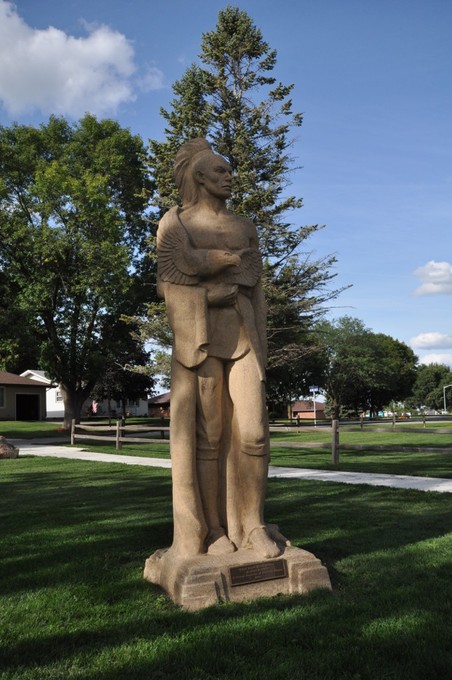Chief Black Hawk Statue
Introduction
Text-to-speech Audio
This statue honors Black Hawk (1767-1838), the Sauk Indian war chief who is primarily known for his role in the Black Hawk War, which occurred 1832. Created by artist Harry E. Stinson in 1934, the statue is made of concrete and depicts Black Hawk standing and holding a hawk and a bow. It is located in Camp Crescent in the town of Lake View and is near the shore of Black Hawk Lake. The statue is significant for its association with the federal, "New Deal" relief jobs programs during the Great Depression that supported arts and culture. Specifically, it served as the foundation of a program called the Public Relief Works of Arts Projects (PWAP), which became a model for other arts relief programs. It was added to the National Register of Historic Places in 1934.
Images
The Chief Black Hawk Statue is the work of artist Harry E. Stinson. Created in 1934, it depicts Sauk war chief Black Hawk standing and holding a bow and a hawk.

Backstory and Context
Text-to-speech Audio
The idea for the statue originated in 1932 from the Lake View Commercial Club and a member of the Iowa State Conservation Commission, Dr. E.E. Speaker. It was part of a broader effort, in collaboration with federal relief programs, to establish the nearby Black Hawk State Park as well as make lake improvements. Through an intermediary, Speaker and the Commercial Club presented their plan the president of the University of Iowa and the dean of the School of Fine Arts, both of whom agreed to the proposal. The project was assigned the project to Harry Stinson, who taught at the university in the department of graphic and plastic arts. The Commercial Club agreed to pay him and all other expenses. In 1933, Stinson made two, three-foot models of Black Hawk. One depicted Black Hawk wearing a robe and carrying a spear. The Commercial Club selected the other model described above.
Stinson did not create the statue itself; it was made by five artists assigned to the project by the Civil Works Administration, which funded the PWAP. It appears that the PWAP supplied the $225 for this part of the project to the town of Lake View, which paid for the fabrication of the statue. The site itself was prepared by workers of another federal agency called the Civilian Conservation Corps. The statue was dedicated on September 3, 1934. The success of the project inspired other towns in Iowa to embark on arts-related projects of their own using guidelines developed by the University of Iowa. The PWAP only ran from December 1933 to June 1934 but it served as the model for future federal arts relief programs, notably the Federal Project One programs administered by the Works Progress Administration.
Despite the lake bearing his name, Black Hawk probably never came here since the lake was outside of Sauk territory. In 1832, he became famous for leading around hundreds of warriors from Iowa into Illinois, presumably in an attempt to recapture Sauk lands. U.S. Army troops and their Indian allies pursued them, culminating in the Battle of Bad Axe on August 1-2, which occurred in southwestern Wisconsin near the present-day town of Victory along the Mississippi River. The battle is more accurately described as a massacre as troops killed around a 150 men, women, children, and the elderly as they tried to cross the river. Black Hawk survived but surrendered and remained in captivity for several months. He was allowed to return to Iowa and lived for the rest of his life in a village along the Des Moines River in present-day Van Buren County.
Sources
Conrad, Rebecca et al. "Chief Black Hawk Statue." National Park Service - National Register of Historic Places Nomination Form. May 26, 2000. https://s3.amazonaws.com/NARAprodstorage/lz/electronic-records/rg-079/NPS_IA/00000532.pdf.
Wikimedia Commons: https://commons.wikimedia.org/wiki/File:LakeViewIA_ChiefBlackHawkStatue.jpg
